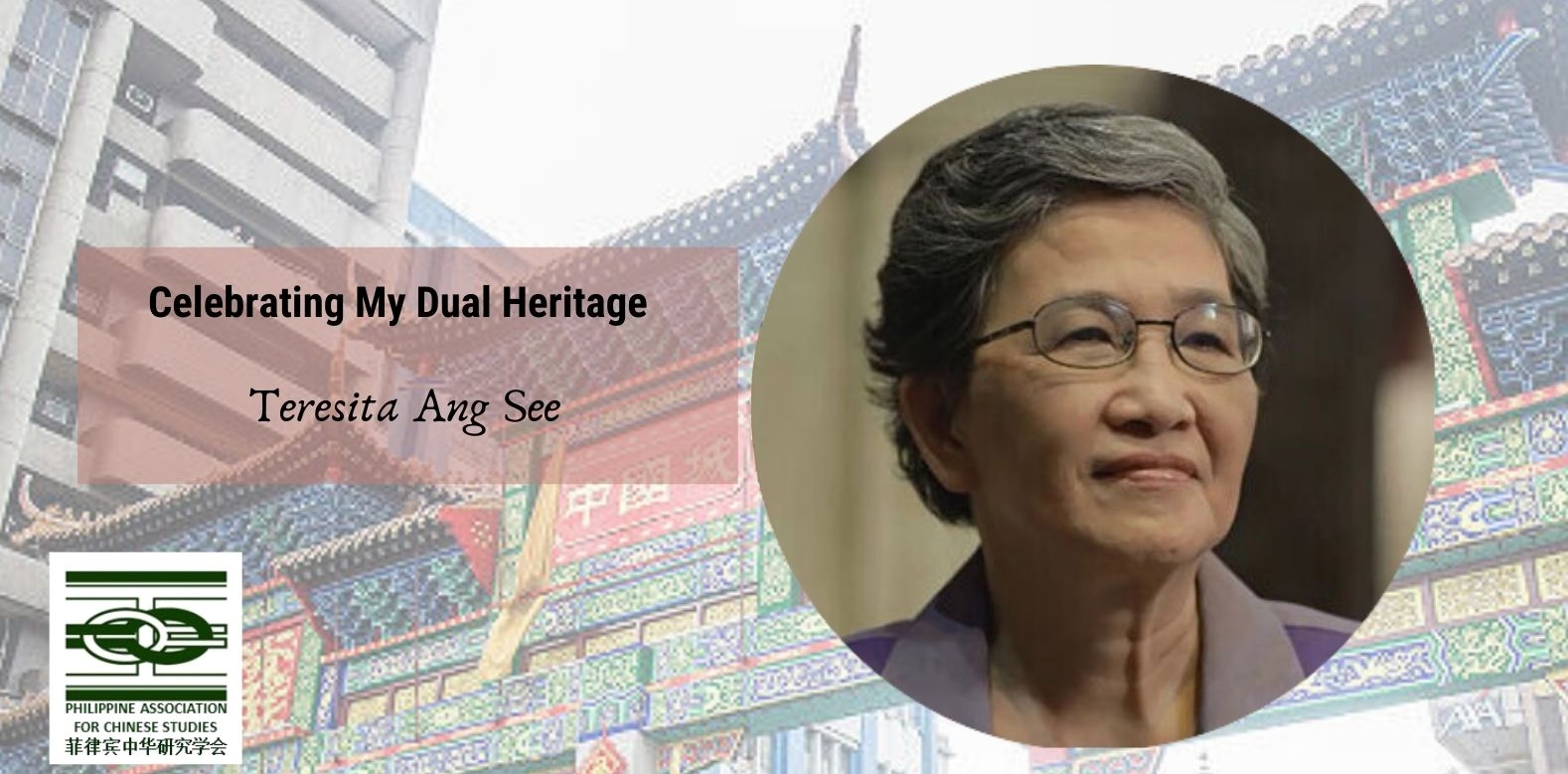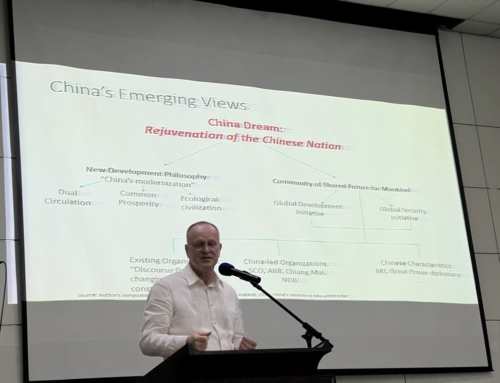By Teresita Ang See
16 December 2020 – I never knew I was different until we moved from my childhood home in Panghulo, Malabon, to Binondo, the bastion of ethnocentrism and traditionalism.
I was born in Binondo but I have no memories of childhood there. I learned about the Binondo extended family from stories about the day I was born. It was early morning on Christmas day 70 years ago. Apparently, the Ang extended family lived together – di-pe, sa-pe (second and third older brothers of my dad) and ah-ko older (older sister of my dad) and their families and ours. My dad was winning in mahjong and refused to stand up when my mom was having continuous contractions. It was Ah-ko who noticed and asked my father to bring mom to the hospital. Being the fifth child, they know it will be quick. True enough, my mom said the doctor didn’t even have time to get out of her Christmas party dress and had to rush to bring me to the world.
My earliest memories of childhood were of growing up in Malabon, which was still a very rural town. My parents decided to try their hand at raising poultry there. I don’t remember having any Chinese neighbors but recalled only that I played with Filipino kids, running, climbing trees, picking up berries and other fruits everywhere.
We lived in a wooden hut, typical bahay kubo with windows all around which brought in strong breezes throughout the day. There were huge mabolo, santol and tamarind trees in the backyard, shading the house. At night, tuko (gecko) would be heard loudly. I helped pick sampaguita buds which women would string into garlands and sell. I tagged along with my siblings when they swam in the rivers, obeying the strict admonition that I was not to go into the waters. I must have been about four years old then. I remember the very clean river and the big kids picking up talangka (small crabs) and putting them in water dippers to be brought home as food. We picked siniguelas (Spanish plum), camachile (Manila tamarind), and duhat (black plum) everywhere. Our water came from a deep well that occasionally had some butete (tadpoles) in them. Drinking water was placed in a banga (large earthenware jug) that always gave us cool water.
On moonlit nights, I watched my siblings and the neighbors’ kids play tumbang preso and patintero or we would sit down and sing songs. We learned a lot of Filipino folk songs. Bahay Kubo (My Nipa Hut) was part of growing up and we would go around the neighborhood identifying the vegetables enumerated in the song. My strong identity as a child in a Filipino neighborhood must have formed the early identification with the Filipino part in me. Despite being of Chinese descent, I experienced no discomfort in playing with Filipino children and dealing with Filipino neighbors then. My eldest brother, however, who was just brought back home after staying for a year in China, was the butt of kids’ funning and mimicking. He pronounced posporo as poporo, and lapa for dapa – meaning he couldn’t use ‘s’ or ‘d’. We were not bothered by the kids having fun with his pronunciation nor did we consider it as a form of bullying.
It was when we moved to Binondo that I became conscious of my dual heritage. Having grown up in Malabon, I didn’t speak Chinese at all when I was enrolled for Grade 1 at the Anglo- Chinese Elementary School. No one spoke Filipino in school, only Hokkien. The Chinese teachers were stern, strict, and terrors . The English teachers were more approachable. I did well in my English classes but dismally in Chinese. But I learned to speak Hokkien quite fast, it’s as if I didn’t even have to re-learn it. Probably, hearing my parents speak in Hokkien rubbed off on us kids even if we didn’t speak it as our home language.
I stayed in the confines of parochial Binondo until I got married. I was a product of the bastion of conservatism and sinocentrism in elementary and high school (Chiang Kai Shek High School). To say that I suffered “culture shock” when I went to college at the University of the Philippines is to put it mildly. My freshman year at UP was an exposure to a totally different world. My classmates were more intelligent, well-off, cosmopolitan and above all, their concerns were more relevant than what I myself had encountered within Binondo. Even the Philippine history lessons I learned in high school were somewhat overturned in my freshman Philippine history class.
In Chinese classes in high school, we were educated and prepared for life in the Chinese community and not for mainstream society. We memorized China’s provinces, products, rail system, and rivers. We memorized Chinese history lessons, with hardly any understanding. What I learned of Chinese history I learned in college when I started reading about Asian civilizations. We memorized lessons in classical Chinese wenyuan wen (文言文) and translated into baihua wen (白话文). We called literature classes guowen (國文) and called Chinese language guoyu (國語) without realizing that for us, guoyu should be Filipino. [These were modified after the Filipinization of Chinese schools was implemented in 1976]. The stories we read were about famous Chinese heroes and characters. Later, I would lament that in our English classes, we did not learn much about Filipino national heroes, literature, philosophy, or geography as extensively as what we learned about China in our Chinese classes. I would recommend to Filipino educators to emulate the Chinese way of teaching values in school through the stories of nobility, hard work, and sacrifices of heroes and ancestors living and dead. Stories of discipline, love of family and country, hard work, frugality, and honesty should be dinned into our curriculum.
My siblings and I were not conscious that we were adept at negotiating our subjective identities and crossing cultural barriers. It was something automatic. As children in Malabon, we were Filipinos, unaware of the Chinese identity that was part of our blood and heritage. In the predominantly Chinese Binondo neighborhood and school, we were forced to transform and assert our Chineseness by learning to speak only in Hokkien. Even our house helpers from Aklan learned to speak Hokkien fluently from my mother. Relatives from Hong Kong who came to stay or just to visit would borrow our household helpers because of their Hokkien-speaking ability.
College years in UP honed me to become the social activist that I am –to seek social relevance, not to be a bystander as important events in national society unfolded. It was a significant turning point. It was also at UP and in my subsequent work in pushing the integration agenda as the primary mandate of my organization, Kaisa Para Sa Kaunlaran, that I learned to value my dual heritage as a contribution to national society. I had to educate my Filipino friends how most Tsinoys speak fluent Filipino as a first language and home language, that we can be both Chinese and Filipino at the same time, that not all Tsinoys are in business nor rich and not all Tsinoys do well in Math. Enhancing understanding of who and what the Chinese Filipinos are, what their dual heritage can contribute for nation-building, has been an important work of Kaisa. We promote the understanding that as Chinese Filipinos, our blood may be Chinese but our roots are deep in Philippine soil and our bonds are with the Filipinos. We take pride in the realization that there is and should be no contradiction between being comfortable in our primary identity as Filipinos, yet recognizing our Tsinoy roots and heritage. In short, we impart the value of being Filipinos in political and economic identity but we take pride in our Chinese blood and ancestry and celebrate the cultural legacy and heritage of our Chinese forebears.
*The Philippine Association for Chinese Studies, for which this commentary is written, recognizes that the study of the Chinese in the Philippines is an indispensable part of both Philippine studies and China studies.






Thanks, Tessie, for sharing your story. I can easily identify myself with your experiences.